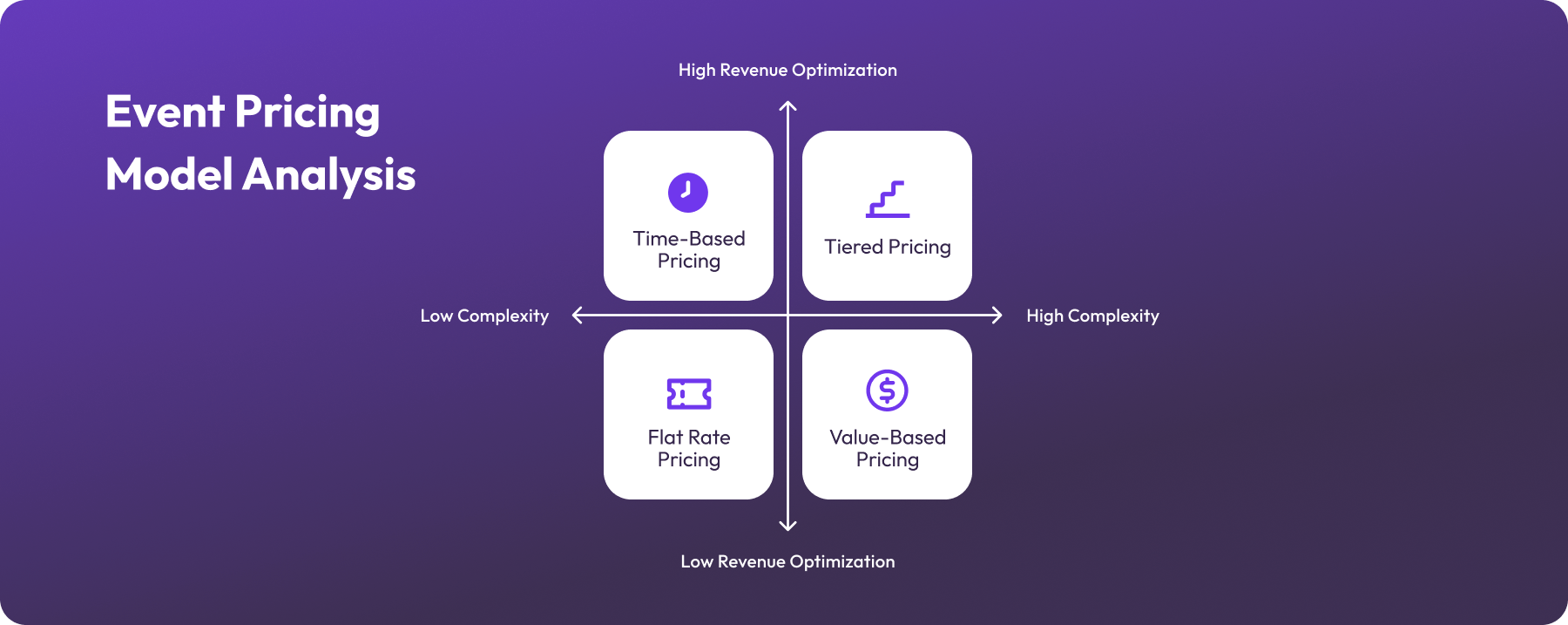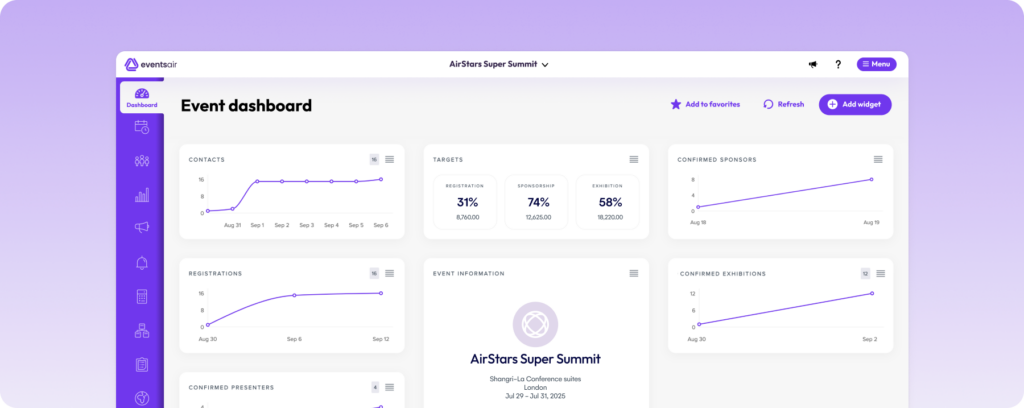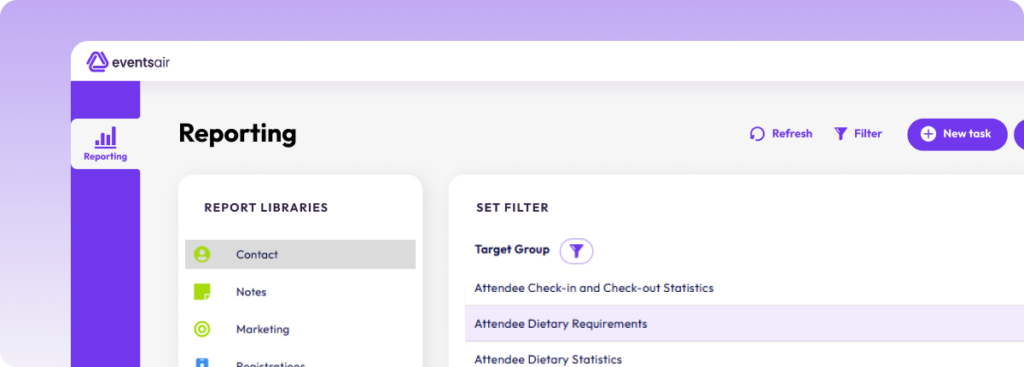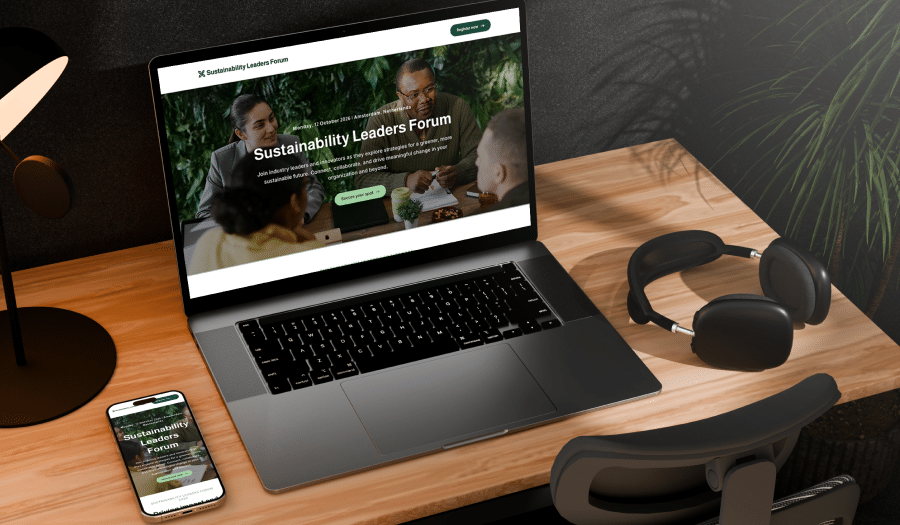
Pricing your event isn’t just about covering costs, it’s about positioning, perception, and maximizing demand. Set prices too high, and you scare off your audience; too low, and you undervalue your event.
The right event pricing strategy finds the sweet spot that boosts both attendance and revenue. It’s also how you differentiate your event in a crowded market.
In this EventsAir guide, we’re going to break down how to build an event pricing strategy that maximizes ROI, without leaving money on the table or losing attendee interest.
What is an event pricing strategy?
An event pricing strategy is the approach you use to set prices for your event, whether you’re charging attendees, sponsors, or exhibitors. It’s not just about covering costs. It’s about aligning price with the value your event delivers.
A well-thought-out pricing strategy is essential for:
- Maximizing revenue
- Driving attendance
- Improving ROI
Set the price too high, and you risk losing registrations. Set it too low, and you may hurt perceived value or fail to break even. The right pricing can balance both.
Event pricing also connects directly to your broader event planning process. It impacts:
- Budgeting and forecasting
- Registration workflows
- Attendee experience
- Marketing and promotion
Factors that influence event pricing
- Type of event: Whether in-person, virtual, or hybrid, the format affects everything from production costs to perceived value, ultimately influencing how much you can charge.
- Target audience and expectations: Different audiences have different price sensitivities. A senior executive may expect (and be willing to pay for) a premium experience, while a broader audience might prioritize affordability.
- Event goals: Are you aiming for profit, lead generation, or brand exposure? Your goal will shape whether you charge a premium, offer tiered pricing, or provide free access to maximize reach.
- Budget and cost structure: Costs like venue, speakers, and tech set the minimum for viable pricing. With EventsAir’s budgeting and forecasting tools, you can map out your cost structure and break-even point with accuracy.
- Competitor pricing: Knowing what similar events charge gives you useful context, but your pricing should ultimately reflect your unique value and positioning.
How to build a strong event pricing strategy
1. Understand your audience
Effective event pricing begins with thorough audience research. Without a clear understanding of your target attendees, pricing decisions become arbitrary, potentially leading to low registration rates or perceived value mismatches.
Define your audience demographics and expectations
Your pricing should reflect your attendees’ professional level, industry, income, and what they value most. Different segments react differently to price, so it’s crucial to identify these differences early.
It’s also important to note that your overall strategy needs to be reflective of these expectations as well. If your attendees are looking for engaging, high-quality content, but you’ve prioritized a boutique venue to enhance their experience rather than sourcing the ideal speakers, then you’re already starting out behind.
Conduct targeted market research
Use data to build your strategy:
- Demographic analysis: Age ranges, professional titles, and geographic distribution
- Psychographic insights: Values, expectations, and event attendance motivations
- Budget thresholds: What similar events do they attend, and at what price points?
- Value drivers: What elements justify premium pricing for this specific audience?
Identify key value propositions
Understanding what your audience considers valuable helps position your pricing effectively. Key value drivers may include:
- Networking opportunities with industry leaders
- Exclusive content or early access to information
- Convenience factors and time-saving elements
- Status and prestige associations
- Direct access to influencers or decision-makers
2. Choose the right pricing model
Once you understand your audience, select the appropriate pricing model. The wrong model can limit revenue potential, create confusion, or fail to capitalize on different attendee segments.
Evaluate pricing model options
Different events require different approaches to pricing. Consider these key models:

- Flat rate pricing: One consistent price for all attendees, offering simplicity but limited revenue optimization
- Tiered pricing: Multiple price points with increasing value/access levels, maximizing revenue across different budget levels
- Time-based pricing: Early bird, regular, and last-minute rates that incentivize early registration
- Group pricing: Discounted rates for multiple attendees from the same organization
- Value-based pricing: Set prices based on how much attendees perceive the event’s value.
- Pay-what-you-want / donation-based: Often used by nonprofits or educational events, allowing attendees to choose their payment.
TIP: Tiered pricing consistently outperforms flat-rate models, increasing average order value by 15-25% when properly structured with clear value differentiation between tiers.
If this feels overwhelming, our easy-to-edit Event Budget Template can give you a clear, confident start.
Design effective pricing tiers
When implementing tiered pricing, ensure each level offers distinct, meaningful benefits:
- Basic/general admission: Core event access with essential features
- Mid-tier/professional: Enhanced experience with moderate exclusivity and additional benefits
- Premium/VIP: Exclusive access with significant added value like private networking, premium content, or personalized experiences
TIP: A common mistake is offering tiers with minimal differentiation. Each tier should deliver at least 25-30% more perceived value than the previous one to justify price increases.
EventsAir’s all-in-one event management platform simplifies pricing and registration setup. Use built-in tools to create multiple pricing tiers effortlessly. Our dynamic registration builder lets you customize pricing flows that match your audience segments, reducing confusion and maximizing revenue.

3. Benchmark competitors
Competitor analysis provides critical context for your pricing decisions. Without understanding market rates, your event may be inadvertently positioned as overpriced or undervalued.
To achieve this:
Research comparable events
Analyze similar events in your industry to establish baseline pricing expectations.
- Direct competitors: Events with similar focus, audience, and programming
- Indirect competitors: Adjacent industry events that might attract your target audience
- Historical trends: Check the most recent data-driven trends and analysis. This shows you how pricing has evolved in your event category over recent years
Analyze value-to-price ratios
Competitive pricing isn’t just about being cheaper, it’s about delivering superior value.
- Feature comparison: What do competitors offer at each price point?
- Unique selling points: How does your event differentiate from similarly priced options?
- Value gap analysis: Identify where competitors under-deliver and how you can capitalize
For example, if similar industry conferences charge $500 for basic access, pricing yours at $700 would require clear justification through exclusive content, prominent speakers, or enhanced networking opportunities that competitors don’t offer.
4. Test and iterate
Pricing strategy isn’t a one-time decision but an ongoing optimization process. Without testing and refinement, you miss opportunities to maximize revenue and attendance. Data-driven price testing ensures continuous improvement and market responsiveness.
Implement strategic price testing
A/B testing different pricing approaches reveals what resonates with your audience:
- Early-bird vs. flash sale promotions: Which drives more immediate registrations?
- Discount thresholds: Testing different percentage or dollar-amount discounts
- Value-add vs. price reduction: Whether audiences prefer lower prices or additional benefits
- Promotional timing: Optimal windows for different pricing incentives
Gather actionable feedback
Audience insights should inform ongoing pricing refinements.
- Post-purchase surveys: What influenced buying decisions?
- Abandonment analysis: Why did potential registrants fail to complete purchases?
- Price sensitivity mapping: At what thresholds do different segments hesitate or convert?
- Post-event evaluation: Did attendees feel they received appropriate value for their investment?
Monitor key pricing metrics
Track performance indicators to assess pricing effectiveness:
- Conversion rate by tier: Percentage of visitors who purchase each pricing level
- Average order value: Total revenue divided by number of transactions
- Upgrade frequency: How often attendees choose to move to higher tiers
- Discount utilization: Which promotional offers drive the most registrations
EventsAir provides comprehensive event analytics that track these metrics in real-time, allowing organizers to make data-driven pricing adjustments throughout the registration period.

5. Leverage pricing psychology
Understanding behavioral economics principles can significantly impact purchasing decisions. Without applying psychological pricing tactics, you risk missing key opportunities to shape perception and drive conversions.
Apply proven psychological pricing techniques
Several behavioral economics principles can enhance your pricing strategy:
- Price anchoring: Presenting higher-priced options first makes subsequent options seem more reasonable
- Decoy effect: Strategically positioning a middle-tier package to make premium options appear more valuable
- Loss aversion: Emphasizing what attendees miss by not purchasing (rather than what they gain)
- Urgency triggers: Limited-time pricing that creates immediate action motivation
- Charm pricing: Using prices ending in 9 or 7 to create perception of better value
For example, consider this strategic pricing table:
- General Admission: $100
- Premium Access: $180 (includes basic features only)
- VIP Experience: $200 (includes early access, exclusive networking, and VIP reception)
Here, the premium tier serves as a decoy, making the marginally more expensive VIP option appear significantly more valuable.
Craft compelling pricing communication
How you frame and present pricing dramatically affects perception.
- Emphasize savings rather than costs (“Save $100” vs “Pay $300”)
- Create scarcity messaging (“Only 5 VIP tickets remaining”)
- Bundle related items to increase perceived value
- Highlight the per-day or per-session value rather than total price
- Use social proof to validate pricing. For example, use “Join 500+ professionals who chose our VIP experience.”
TIP: Visual presentation matters; use clear pricing tables, color psychology, and strategic placement to guide attention toward higher-value options.
6. Analyze results and refine strategy
Post-event analysis provides crucial insights for future pricing optimization. Without detailed performance reviews, valuable learning opportunities are missed.
Evaluate pricing performance metrics
Assess key indicators to measure pricing strategy effectiveness:
- Revenue achievement vs. targets
- Attendance distribution across pricing tiers
- Discount utilization and impact on overall revenue
- Registration timing patterns related to price changes
- Upgrade and cross-sell success rates
TIP: Compare these metrics against previous events or industry benchmarks to identify areas for improvement. With EventsAir, you will always have access to your event data, allowing easy historical benchmarking.
Collect strategic feedback
Targeted post-event research reveals subjective pricing perceptions:
- Attendee satisfaction surveys with specific pricing-related questions
- Value perception analysis across different pricing tiers
- Competitive comparison feedback from repeat attendees
- Qualitative feedback on price-to-value alignment
EventsAir’s post-event survey guide integrates directly with registration data, allowing you to correlate feedback with specific pricing tiers and purchasing behaviors for more nuanced analysis.

Implement strategic refinements
Use analyzed data to evolve your pricing approach.
- Adjust tier structures based on popularity and profitability
- Refine value propositions for underperforming price points
- Optimize promotional timing based on registration patterns
- Enhance value communication for tiers with lower-than-expected adoption
TIP: Conduct your pricing analysis within two weeks of event completion, while experiences remain fresh for both organizers and attendees.
7. Simplify payment processing to maximize conversions
Even with the perfect pricing strategy, a complicated or limited payment process can cause friction and lead to abandoned registrations. Ensuring a smooth, flexible, and secure payment experience is critical for converting interest into revenue.
Offer multiple payment methods
Support diverse payment preferences to reduce drop-offs:
- Credit/debit cards, PayPal, bank transfers
- Support for local currencies and international transactions
- Invoice options for corporate or group registrations
Minimize checkout friction
Streamline the process to boost conversions:
- Mobile-optimized, intuitive checkout flow
- Save attendee information for future events
- One-click upgrades or add-ons during registration
Ensure security and trust
Payment security builds confidence:
- PCI-compliant processing systems
- Display security badges and SSL encryption
- Transparent refund and cancellation policies
Integrated solutions save time and reduce errors
Streamline your event payment processes with platforms like EventsAir Pay. By centralizing transactions, automating workflows, and reducing manual input, you can save time and minimize errors, just as the Dellar Davies team did when they simplified operations and gained full control over their payment management.
Maximize your event revenue with smarter pricing
A successful event pricing strategy can make or break your ROI. From understanding your audience to leveraging psychological pricing and post-event analysis, every detail counts. But juggling models, tiers, and market trends can quickly become overwhelming without the right tools.
That’s where EventsAir helps you win. With built-in features like dynamic registration flows, real-time analytics, and integrated payment processing through EventsAir Pay, you can confidently design, test, and refine pricing strategies that convert.
Ready to streamline your event pricing and boost profits with ease? Reach out for a demo today!
Best Practice | Event Marketing
See EventsAir in action
Discover why 12,000+ event professionals trust EventsAir to deliver effortless events, every time.




